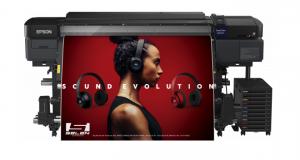Straight Talk With Epson

There is no doubt within world of digital printing Epson is a powerhouse. The company is a major manufacturer of printers as well as projectors and industrial robots. As part of our ongoing interview series with top managers of global graphic arts companies we caught up with Shihab Ahmed Zubair, Epson’s regional sales manager. During our extensive Q&A session Zubair offered a rather clear picture of Epson’s portfolio as well as company’s post Covid recovery strategy.
In January, Epson launched its first industrial direct to garment printer. First of all, why did it take Epson so long to enter this market and does Epson plan to focus more on this market?
Epson actually entered this market back in 2003 when we launched the Monna Lisa 160B Inkjet Textile Printer, which was jointly developed in collaboration with leading Italian textile manufacturing equipment manufacturer, Robustelli S.R.L., now part of our Group. The new release is not only a culmination of our long-standing experience in the field but also the first of many products that we aim to introduce for this important market segment.

What about soft signage and textile? Following the launch of Epson’s first fluorescent ink, dye-sublimation, textile printing solution in 2019, are there any plan in the works to launch new products for textile printing?
While Epson launched the first Dye-Sublimation printer in 2012, we were already a major contributor to the segment, as most of the major players in the market at the time were utilizing our print head technology as part of their own solutions. In that same year, the company decided to enter the market with two new products, the F6000 and F7000, which were the first in the industry to be fully manufactured by a single vendor. And from that time, we continued the development of our range and with the launch of the F9400H, Epson’s first dye sublimation printing solution, we are now able to highlight two genuine fluorescent inks — yellow and pink. These bring bright and vivid colors to the production of sportswear, workwear, and fashion items.We’re continuing to work on new products that will bring a host of other features to the table, including higher productivity and the capability to print at bigger sizes.
What is Epson’s strategy to engage with its customers during post-COVID recovery?
Over the course of the ongoing global crisis, we continued to engage with our customers, remaining in constant dialogue throughout. As part of that engagement, Epson conducted several training sessions with our clients, highlighting different ways they could use our technologies to keep their operations moving, while at the same time generating new business and introducing novel solutions that would enable them to meet the demand in the market. We will continue to work closely with our clients to build and implement an effective post-COVID-19 recovery plan together.
Please explain how COVID 19 impacted Epson and what was Epson’s contribution to the healthcare industry to overcome the crisis? Did Epson also manufacture masks?
Like many other industries, we were affected by both the lock down and the economic impact of the ongoing global crisis. Factories and partners around the world helped with production of face visors and masks. As part of our efforts to generate new business during this difficult time, we discovered a new opportunity within the creative mask manufacturing space with many of our F-Series products being utilized to produce customized face masks.
Recently Epson launched a number of portable label makers, do you see many opportunities in this market?
Label printers was one range of products that experienced growth during this crisis. This was due to the increasing need for customized colored, short run labels, as well as a need for effective mobile solutions such as our portable label makers. In particular, our on-demand ColorWorks label printers have been used to support labelling for the growing take-away food business and also in labelling for gels and hand sanitizers.
In which way Epson is involved in augmented reality technology?
Epson launched its MOVERIO Smart Glasses in 2011, and the technology is now in its third generation of development. The glasses have found real case uses in the commercial environment as well as in tourism and leisure.

Here are some examples:
- Remote technical assistance. Epson’s Moverio Augmented Reality smart glasses are now used widely in remote assistance, a demand that has grown in recent years, where the glasses deliver better productivity, lower costs, improved customer service and – importantly – a much reduced carbon footprint. There ae users now in pharmaceuticals (Marchesini), rubber manufacturing (Saargummi), railway manufacturing (Siemens), food and drink (SIG) and packaging (Comexi).
- Remote marketing and selling using Moverio (VW Group – Audi Cars) which was implemented in 2019 but illustrates how Epson’s technology is helping to provide additional and unforeseen benefits in these changed times. We expect the use of the glasses in remote selling to grow post-pandemic.
- Providing better tools (offering line of sight) for both commercial and recreational drone pilots
- Enhancing visitor experiences across the arts, entertainment, and tourism industries.
- Improving industrial workflows to reduce human error, minimize travel cost, and increase safety across operations
Epson is a company offering a wide range of products, including wearable and robotics however the general perception is that Epson is basically manufacturer of printers, do you believe there is more to be done to change this perception?
To date, our portfolio of printing solutions represents around two thirds of our company’s revenue. It is an area of our business that we continue to refine further, particularly with the original Micro Piezo Inkjet technology, where we aim to achieve higher productivity, better environmental performance, and deliver a sustainable printing ecosystem. In addition to our printing division, we have focused our efforts on achieving innovation in two other areas of business:
Projectors: Perhaps not fully appreciated is the fact that Epson is the market leader in projectors – in terms of volume and value share – a position it has held globally for 18 years running. Epson’s unique proprietary 3LCD technology delivers bright, vivid, natural-looking color images. We are continuing to expand our high lumens offering, and our ultra-short-throw projection technology is increasing used in corporate and educational environments.
Industrial Robots: Another lessor know fact is that Epson is one of the world’s leading manufacturers of robots and has been the global market share leader in SCARA robots for eight consecutive years with an extensive lineup of SCARA models for a wide range of applications.
Many manufacturers including Epson organized virtual shows to display their new products, do you think that virtual shows eventually will replace exhibitions such as drupa in near future?
These virtual events are important and will continue to grow post pandemic but I don’t think they will ever fully replace the main industry events, especially within the commercial and industrial printing segment. We find that many of our customers prefer to touch and feel the final product, which then provides them with a better understanding of the total solution. So, I think DRUPA, FESPA, SGI, and EgyStitch will always be there and will remain crucial venues for us to showcase our latest offerings.
Coronavirus crisis disrupted many norms and standard practices, as far as manufacturing is concerned. Do you think Epson will adopt a whole new approach towards manufacturing and what kind of products will the company want to launch to market? Will we see more environmentally friendly products?
Even before the advent of COVID-19, sustainability was central part of Epson’s vision as an organization. In 2008, the company announced its Environmental Vision 2050, a new initiative that highlighted our environmental goals leading up to 2050. With immediate effect, we began focusing our efforts on achieving the goals set out by our organization’s leadership.
Our efforts to reduce the environmental impact of our products has resulted in the creation of new designs featuring increased productivity, production process and product energy efficiency, resource efficiency, as well as eliminating the use harmful and hazardous substances typically found in traditional printing solutions.
- Compact, lightweight, energy-efficient Epson products that are designed for long life and easy recyclability and have a lower environmental impact across their life cycles
- Epson produces attractive products engineered for easy maintenance and chemical safety
There is a certain cautious optimism within the printing industry, because the commercial and industrial activities are picking up in some countries including China. Do you also see more activities in our region following the COVID-19 crisis?
I believe in such a crisis there will always generate new opportunities, particularly with small and medium businesses. For our part, we’ve seen an uptick with our textile and signage solutions as well as increased interest with digital labeling products across the region. And to maximize these developments, Epson is always keen to provide our clients with the latest innovations and solutions that address the challenges faced by our customers in this situation.






84 Comments